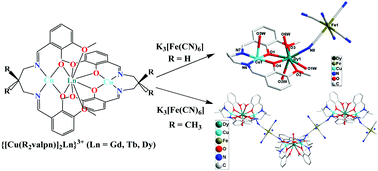Ligand-directed assembly of trinuclear and one-dimensional heterotrimetallic CuIILnIIIFeIII complexes: unusual antiferromagnetic CuIIFeIII coupling via cyano bridges†
Abstract
New heterotrimetallic complexes [Cu(valpn)(H2O)Ln(H2O)3Fe(CN)6]·xH2O (Ln = Gd, x = 3 for complex 1; Ln = Tb, x = 3 for complex 2; Ln = Dy, x = 1.75 for complex 3; H2valpn = N,N′-bis(3-methoxysalicylidene)-1,3-diaminopropane), {[Cu(Me2valpn)]2Ln(H2O)Fe(CN)6·xH2O·yCH3CN}n (Ln = Gd, x = 5, y = 2.5 for complex 4; Ln = Tb, x = 4.5, y = 1.5 for complex 5; Ln = Dy, x = 5.5, y = 2.5 for complex 6; Ln = Y, x = 6, y = 4 for complex 7; H2Me2valpn = N,N′-bis(3-methoxysalicylidene)-2,2-dimethyl-1,3-diaminopropane) have been synthesised by a reaction of Cu(valpn) (or Cu(Me2valpn)), Ln3+ and [Fe(CN)6]3− in a molar ratio of 2 : 1 : 1. Complexes 1–3 have a CuLnFe trinuclear structure, consisting of phenoxo-bridged Cu–Ln and cyano-bridged Ln–Fe moieties. Complexes 4–7 contain phenoxo-bridged Cu2Ln units that are connected by [Fe(CN)6]3− to form a one-dimensional (1D) zig-zag structure. In the trinuclear complexes 1–3, the [Fe(CN)6]3− anion coordinates to Ln3+, whereas it coordinates to Cu2+ in complexes 4–7. Magnetic studies demonstrate that there exists a ferromagnetic interaction between Cu(II) and Gd(III) ions via the phenoxo bridges, while the cyano-bridges transit antiferromagnetic coupling between low-spin Fe(III) and Cu(II) or Gd(III). The fitting to the magnetic susceptibilities of complexes 1 and 4 gave the parameters of JCuGd = 2.392 and 2.945 cm−1, and JFeGd = −0.341 cm−1 and JFeCu = −0.378 cm−1. The ac magnetic measurements reveal that complex 6 shows slow magnetization relaxation with an energy barrier of 12.3 K and a relaxation time of τ0 = 1.65 × 10−6 s, which is typical of a single-chain magnet.


 Please wait while we load your content...
Please wait while we load your content...